The Russian-American research team has presented a new therapeutic method using nanoparticles of an antioxidant enzyme, developed specifically for the eyes. It relieves inflammation and repairs tissue without causing side effects: irritation and allergies, even at high doses. The results of the research are presented in the international scientific journal
Biomedicines.
A team of scientists from NUST MISIS, Lomonosov Moscow State University, Helmholtz National Medical Research Center of Eye Diseases and the University of North Carolina solved the problem of overproduction of free radicals by creating multilayer polyion nanoparticles of the superoxide dismutase enzyme (Nano-SOD1), designed specifically for the eyes.
“The ability of Nano-SOD1 to reduce inflammation in the eye was examined in vivo in rabbits with model immunogenic uveitis — the inflammation of the inner vascular tract of the eye. It was shown during preclinical studies that topical instillations of Nano-SOD1 were 35% more effective in reducing the manifestations of uveitis compared to the free enzyme SOD1," said Alexander Vaneev, engineer of the NUST MISIS Biophysics Research Laboratory, one of the study authors.
"In particular, we noted statistically significant differences in such inflammatory signs of the eye as corneal and conjunctival edema, iris hyperemia and fibrin clots.”
The scientist explained that during the development, the SOD1 nanoparticles previously created by the team were used. However, the new formulation was specially manufactured for topical use in ophthalmology. Optimization of the technology made it possible to increase the efficiency in obtaining Nano-SOD1, as well as to achieve the greatest degree of drug stability.
According to the researchers, Nano-SOD1 penetrates into the inner structures of the eye more than 2 times more efficiently than SOD1 itself. It is much better retained on the surface of the cornea and retains enzyme activity in the eye for a much longer time than the regular SOD1 enzyme without inclusion in the composition of nanoparticles. Scientists have observed inflammation decrease and restoration of antioxidant activity in the eyes.
At the same time, scientists have found during tests that Nano-SOD1 does not show any toxicity (eye irritation, acute, chronic and reproductive toxicity, allergenicity, immunogenicity, mutagenicity) in a wide concentration range and even at extremely high doses used.
At the moment, the developers continue a series of preclinical trials of the obtained drug.
